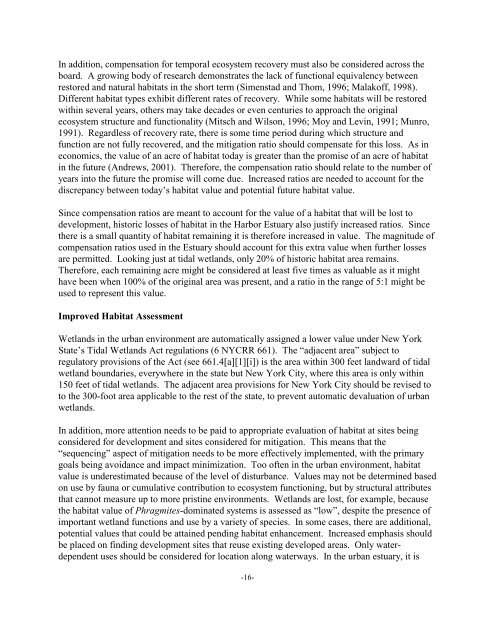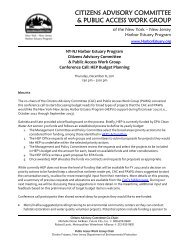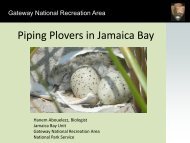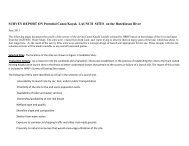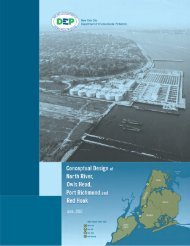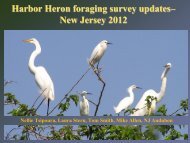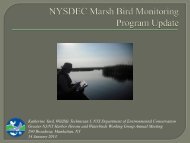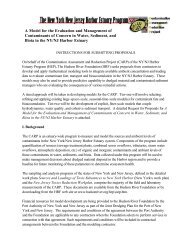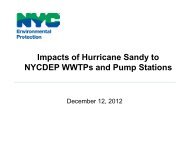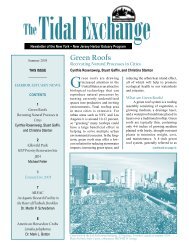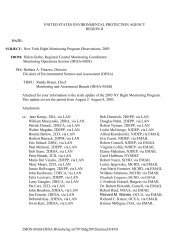DraftMitigation .pdf - New York-New Jersey Harbor Estuary Program
DraftMitigation .pdf - New York-New Jersey Harbor Estuary Program
DraftMitigation .pdf - New York-New Jersey Harbor Estuary Program
You also want an ePaper? Increase the reach of your titles
YUMPU automatically turns print PDFs into web optimized ePapers that Google loves.
In addition, compensation for temporal ecosystem recovery must also be considered across the<br />
board. A growing body of research demonstrates the lack of functional equivalency between<br />
restored and natural habitats in the short term (Simenstad and Thom, 1996; Malakoff, 1998).<br />
Different habitat types exhibit different rates of recovery. While some habitats will be restored<br />
within several years, others may take decades or even centuries to approach the original<br />
ecosystem structure and functionality (Mitsch and Wilson, 1996; Moy and Levin, 1991; Munro,<br />
1991). Regardless of recovery rate, there is some time period during which structure and<br />
function are not fully recovered, and the mitigation ratio should compensate for this loss. As in<br />
economics, the value of an acre of habitat today is greater than the promise of an acre of habitat<br />
in the future (Andrews, 2001). Therefore, the compensation ratio should relate to the number of<br />
years into the future the promise will come due. Increased ratios are needed to account for the<br />
discrepancy between today’s habitat value and potential future habitat value.<br />
Since compensation ratios are meant to account for the value of a habitat that will be lost to<br />
development, historic losses of habitat in the <strong>Harbor</strong> <strong>Estuary</strong> also justify increased ratios. Since<br />
there is a small quantity of habitat remaining it is therefore increased in value. The magnitude of<br />
compensation ratios used in the <strong>Estuary</strong> should account for this extra value when further losses<br />
are permitted. Looking just at tidal wetlands, only 20% of historic habitat area remains.<br />
Therefore, each remaining acre might be considered at least five times as valuable as it might<br />
have been when 100% of the original area was present, and a ratio in the range of 5:1 might be<br />
used to represent this value.<br />
Improved Habitat Assessment<br />
Wetlands in the urban environment are automatically assigned a lower value under <strong>New</strong> <strong>York</strong><br />
State’s Tidal Wetlands Act regulations (6 NYCRR 661). The “adjacent area” subject to<br />
regulatory provisions of the Act (see 661.4[a][1][i]) is the area within 300 feet landward of tidal<br />
wetland boundaries, everywhere in the state but <strong>New</strong> <strong>York</strong> City, where this area is only within<br />
150 feet of tidal wetlands. The adjacent area provisions for <strong>New</strong> <strong>York</strong> City should be revised to<br />
to the 300-foot area applicable to the rest of the state, to prevent automatic devaluation of urban<br />
wetlands.<br />
In addition, more attention needs to be paid to appropriate evaluation of habitat at sites being<br />
considered for development and sites considered for mitigation. This means that the<br />
“sequencing” aspect of mitigation needs to be more effectively implemented, with the primary<br />
goals being avoidance and impact minimization. Too often in the urban environment, habitat<br />
value is underestimated because of the level of disturbance. Values may not be determined based<br />
on use by fauna or cumulative contribution to ecosystem functioning, but by structural attributes<br />
that cannot measure up to more pristine environments. Wetlands are lost, for example, because<br />
the habitat value of Phragmites-dominated systems is assessed as “low”, despite the presence of<br />
important wetland functions and use by a variety of species. In some cases, there are additional,<br />
potential values that could be attained pending habitat enhancement. Increased emphasis should<br />
be placed on finding development sites that reuse existing developed areas. Only waterdependent<br />
uses should be considered for location along waterways. In the urban estuary, it is<br />
-16-


